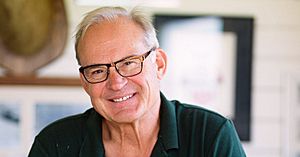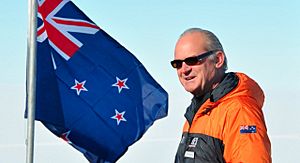Rob Fenwick facts for kids
Quick facts for kids
Sir Robert Fenwick
KNZM KStJ
|
|
|---|---|
 |
|
| Born |
Robert George Mappin Fenwick
5 May 1951 Auckland, New Zealand
|
| Died | 11 March 2020 (aged 68) |
| Occupation | Businessman |
| Known for | Sustainable business development, Antarctic preservation, New Zealand conservation |
| Relatives | Frank Mappin (grandfather) George Fenwick (great-grandfather) |
Sir Robert George Mappin Fenwick KNZM KStJ (5 May 1951 – 11 March 2020) was a New Zealand environmentalist, businessman, and professional director.
Fenwick helped create Living Earth Ltd, a company that makes compost from organic waste. He also co-founded the NZ Natural bottled water brand and Te Matuku Oysters. He held many important roles on boards and advisory groups. His work in conservation and sustainability included leading the Predator Free 2050 movement. He also helped start the New Zealand Business Council for Sustainable Development and had several leadership roles in Antarctica.
Sir Robert was honored in 2016 for his big contributions to New Zealand. These included helping with sustainable development, protecting wildlife, and reducing waste. He also worked on environmental science and supported Māori (iwi) development. A year before, he received the 2015 Blake Medal. This award recognized him as a top leader in sustainability and the environment. He was also a finalist for the 2016 New Zealander of the Year Award. In 2016, he was added to the New Zealand Business Hall of Fame.
Contents
Early Life and Family
Fenwick grew up in Auckland, New Zealand. His father, George de Lacy Fenwick, was an eye doctor. His great-grandfather, Sir George Fenwick, was a newspaper owner and editor. Robert Fenwick went to King's College.
Robert Fenwick's Career
Fenwick started his career as a journalist. He worked for the Auckland Star newspaper and Radio Hauraki. Later, he helped start a public relations company called Allan, Fenwick, McCully.
In 1987, Fenwick co-founded NZ Natural Water Ltd. This company bottled New Zealand water to sell overseas. In 1994, Fenwick and his partners started Living Earth Ltd. This was New Zealand's first company to turn organic waste into compost. By 2010, they had stopped one million tonnes of waste from going into landfills. This waste was then reused as compost.
In 2000, Fenwick and his wife Jennie started Te Matuku Oysters. Their oyster farm is on their property on Waiheke Island. This area is part of the Te Matuku marine reserve, which Fenwick strongly supported. The oysters are farmed in a way that protects the environment. They are sold to local restaurants and have received good reviews.
Leadership Roles and Advice
From 1990, Fenwick took on many consulting and director roles. He gave advice on business plans, government relations, and communication. He often focused on environmental issues and sustainability.
Some of his important positions included:
- Chairman of Mai FM Media (1990–2001). He was very proud of this role because it helped promote the Māori language.
- Deputy Chairman of TVNZ (2004–2010).
- Chairman of Antarctica New Zealand (2008–2015).
- Director for Te Papa Tongarewa (2016 – present). This is New Zealand's national museum.
- Member of the Air NZ Sustainability Advisory Panel (2015–present).
- Member of the Westpac NZ Sustainability & Community Panel (2016–present).
Political Involvement
In 1996, Fenwick became the leader of the Progressive Green Party. He worked to create a Maritime Park in the Hauraki Gulf.
In 1998, he helped create the BlueGreens. This was an environmental policy group within the New Zealand National Party.
Fenwick also helped develop New Zealand's plan to reduce waste. He pushed for the Waste Minimisation Act 2008 to become law. He was the first chairman of the Ministerial Waste Advisory Board from 2008 to 2014.
Protecting Nature and Helping People
Fenwick was highly respected for his conservation work in New Zealand. He is known for inspiring the Predator Free New Zealand 2050 movement. This project aims to remove harmful predators from New Zealand by 2050. He chaired the Predator Free New Zealand Trust, which supports volunteers who control pests. He also chaired The Kiwi Trust, a group working to protect the kiwi bird from extinction.
Fenwick also worked to protect nature in his home city of Auckland. In 1992, he helped start the Motutapu Island Restoration Trust. In 2008, the Fenwick family protected their 360-hectare coastal property. This helped expand the Hauraki Gulf Marine Park, which Fenwick strongly supported. A part of the Fenwick property with trees was also given to the Auckland Council for a public walkway.
From 1998 to 2007, Fenwick was a director and chairman of Landcare Research. This research institute developed the carboNZero program. This program certifies how much carbon emissions a company produces. From 1997, he co-founded and later chaired the New Zealand Business Council for Sustainable Development.
In 1997, Fenwick and a colleague bought Queen Mary Hospital. They hoped to keep it open and attract patients. The hospital faced financial challenges and closed in 2003.
Fenwick's other important work in conservation and helping people included:
- Trustee for World Wildlife Fund New Zealand (1985–2005).
- Special advisor to the Director General of the New Zealand Department of Conservation (2010–2015).
- Chairman of the Fred Hollows Foundation (2010–2014). This foundation works to prevent blindness.
- Board member for the NEXT Foundation (2014–present).
Work in Antarctica
North & South Magazine wrote that "Rob Fenwick has had more impact on Antarctica than possibly any other New Zealander."
In 1993, Fenwick started an international campaign to save the historic Scott and Shackleton huts in Antarctica. He later became chairman of the Antarctic Heritage Trust from 1996 to 2007. After this project, Fenwick was asked to chair Antarctica New Zealand. During his time, the agency built wind turbines to power research stations. The Hillary Science Centre at Scott Base was also completed. In 2012, he created the Antarctic Research Institute. This institute works with other research groups to study climate change in Antarctica.
The Fenwick Ice Piedmont was named after him. This was to recognize his important work in Antarctica.
Awards and Honours
Sir Robert Fenwick received many awards and honours for his work:
- Knight of the Order of St John (2005).
- Companion of the New Zealand Order of Merit (2008). This was for his services to conservation and the community.
- Honorary doctorate from Lincoln University (2009).
- Sir Peter Blake medallist (2015).
- Knight Companion of the New Zealand Order of Merit (2016). This was for his services to business and conservation.
- Finalist for New Zealander of the Year (2016).
- Inducted into the New Zealand Business Hall of Fame (2016).
- Winner of the Kea World Class NZ Awards (2017).
Personal Life
In 1974, Fenwick married Juileen Adams. They had one daughter and later divorced in 1986. He then married Jennifer ("Jennie") Anne Beatty, who was a yoga teacher. They had two more daughters. He and his family lived on Waiheke Island.
Images for kids



